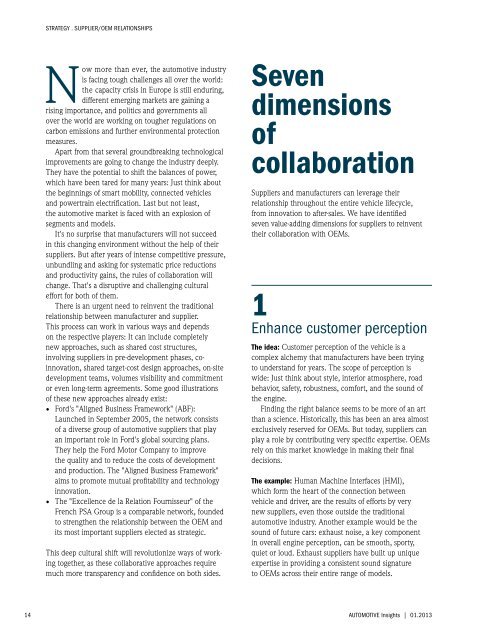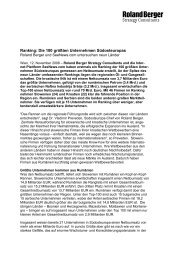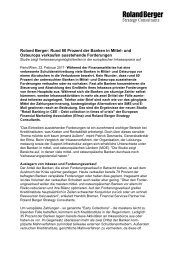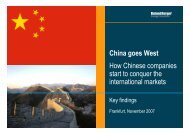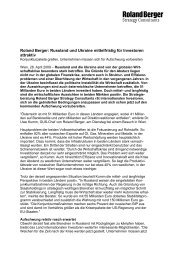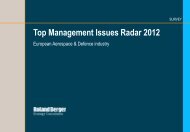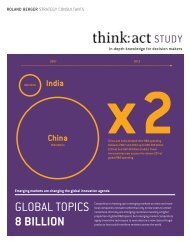Automotive Insights 01.2013 - Roland Berger
Automotive Insights 01.2013 - Roland Berger
Automotive Insights 01.2013 - Roland Berger
Create successful ePaper yourself
Turn your PDF publications into a flip-book with our unique Google optimized e-Paper software.
Strategy . Supplier/OEM Relationships<br />
Now more than ever, the automotive industry<br />
is facing tough challenges all over the world:<br />
the capacity crisis in Europe is still enduring,<br />
different emerging markets are gaining a<br />
rising importance, and politics and governments all<br />
over the world are working on tougher regulations on<br />
carbon emissions and further environmental protection<br />
measures.<br />
Apart from that several groundbreaking technological<br />
improvements are going to change the industry deeply.<br />
They have the potential to shift the balances of power,<br />
which have been tared for many years: Just think about<br />
the beginnings of smart mobility, connected vehicles<br />
and powertrain electrification. Last but not least,<br />
the automotive market is faced with an explosion of<br />
segments and models.<br />
It's no surprise that manufacturers will not succeed<br />
in this changing environment without the help of their<br />
suppliers. But after years of intense competitive pressure,<br />
unbundling and asking for systematic price reductions<br />
and productivity gains, the rules of collaboration will<br />
change. That's a disruptive and challenging cultural<br />
effort for both of them.<br />
There is an urgent need to reinvent the traditional<br />
relationship between manufacturer and supplier.<br />
This process can work in various ways and depends<br />
on the respective players: It can include completely<br />
new approaches, such as shared cost structures,<br />
involving suppliers in pre-development phases, coinnovation,<br />
shared target-cost design approaches, on-site<br />
development teams, volumes visibility and commitment<br />
or even long-term agreements. Some good illustrations<br />
of these new approaches already exist:<br />
• Ford's "Aligned Business Framework" (ABF):<br />
Launched in September 2005, the network consists<br />
of a diverse group of automotive suppliers that play<br />
an important role in Ford's global sourcing plans.<br />
They help the Ford Motor Company to improve<br />
the quality and to reduce the costs of development<br />
and production. The "Aligned Business Framework"<br />
aims to promote mutual profitability and technology<br />
innovation.<br />
• The "Excellence de la Relation Fournisseur" of the<br />
French PSA Group is a comparable network, founded<br />
to strengthen the relationship between the OEM and<br />
its most important suppliers elected as strategic.<br />
This deep cultural shift will revolutionize ways of working<br />
together, as these collaborative approaches require<br />
much more transparency and confidence on both sides.<br />
Seven<br />
dimensions<br />
of<br />
collaboration<br />
Suppliers and manufacturers can leverage their<br />
relationship throughout the entire vehicle lifecycle,<br />
from innovation to after-sales. We have identified<br />
seven value-adding dimensions for suppliers to reinvent<br />
their collaboration with OEMs.<br />
1<br />
Enhance customer perception<br />
The idea: Customer perception of the vehicle is a<br />
complex alchemy that manufacturers have been trying<br />
to understand for years. The scope of perception is<br />
wide: Just think about style, interior atmosphere, road<br />
behavior, safety, robustness, comfort, and the sound of<br />
the engine.<br />
Finding the right balance seems to be more of an art<br />
than a science. Historically, this has been an area almost<br />
exclusively reserved for OEMs. But today, suppliers can<br />
play a role by contributing very specific expertise. OEMs<br />
rely on this market knowledge in making their final<br />
decisions.<br />
The example: Human Machine Interfaces (HMI),<br />
which form the heart of the connection between<br />
vehicle and driver, are the results of efforts by very<br />
new suppliers, even those outside the traditional<br />
automotive industry. Another example would be the<br />
sound of future cars: exhaust noise, a key component<br />
in overall engine perception, can be smooth, sporty,<br />
quiet or loud. Exhaust suppliers have built up unique<br />
expertise in providing a consistent sound signature<br />
to OEMs across their entire range of models.<br />
14 <strong>Automotive</strong> <strong>Insights</strong> | <strong>01.2013</strong>


